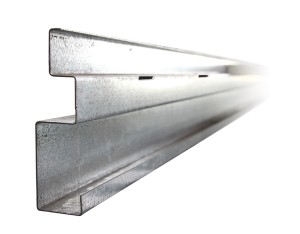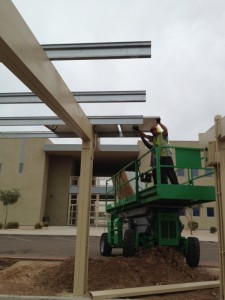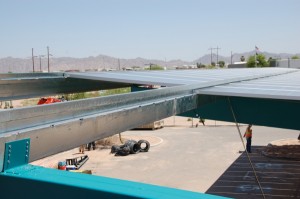Powers Steel’s new carport design provides cost and time savings to purchasers.
Carport solar designs are becoming an increasingly attractive option for businesses wanting to change how they get their power. As installations rise, so does the need for cheaper materials, quicker construction and safer assembly. Powers Steel & Wire Inc., a steel structure and rebar manufacturer based in Phoenix that recently entered the solar market, offers a new carport design that solves all those requirements. Already with a significant partnership with SolarCity under its belt, Powers Steel expects the next few years to be busy for its solar division.
 RETHINKING THE STRUCTURE
RETHINKING THE STRUCTURE
Powers Steel & Wire formed in 1964 manufacturing masonry lintels (load-bearing structural pieces), wires and steel beams. The company has developed over the years into different areas, eventually getting involved with the carport business for apartments. Three years ago, SolarCity approached Powers Steel to sell its panels on the Powers Steel carport structures.
“[SolarCity] wanted to come up with a quicker, faster, easier way to install solar panels in California because unions were costing them a lot of money,” says Powers Steel President John Powers. “At the time, the guys were up on the roof and weren’t tethered off. I came up with the idea to slide a panel into a clip, then I came up with the purlin.”

The Powers Steel slide-in product (branded Powers Solar Frames) consists of horizontal beams, also known as purlins, resting on the main supports. The patent-pending design has an S-shaped purlin at the bottom and an S-shaped purlin with a rail attached at the top of the carport. Installers are able to slide the solar panels between the two purlins very easily, never leaving their scissor lift or getting on top of the structure. Sag rods are attached underneath to provide more support to the panels, and endcaps hold everything together. Bumpons or rubber feet are secured to the panel frames to allocate for thermal expansion, and they allow the panels to slide in as close as possible to each other. L-clips secure the panels underneath.
“The electricians — five good guys who know what they’re doing — can only install around 100 to 150 panels a day,” Powers says of average carport designs. “We just did a job where they can put in 700 to 800 panels a day. We’re quadrupling your production. And you’re never on [top of the panels]; you stay in the scissor lift.”
Powers says a regular carport needs two purlins for each panel. With the Powers Steel product, there’s only one purlin per panel. The Powers Steel purlin is slightly more expensive than regular purlins, but these carports use half the number.
“Our price is $3 per foot and they’re used to paying $2.75 per foot for their purlins,” Powers says. “They say ours cost more, but they’re forgetting they use basically 50 percent less purlins.”
EXPANSION OF POWERS
Currently, Solar Frames is the smallest of Powers Steel’s four divisions, but Powers believes it will become the largest in two years. The company’s initial partnership with SolarCity has been helpful in getting people familiar with the product. Powers Steel has done more than 100 jobs with SolarCity across the country.
 “If you have a good hamburger and people like it, they tell everyone else, and before long, you’re selling a lot of hamburgers,” Powers says.
“If you have a good hamburger and people like it, they tell everyone else, and before long, you’re selling a lot of hamburgers,” Powers says.
Powers Steel’s marketing involves reaching out to primary contractors and developers and ramping up its presence at industry conferences. Right now, the company’s carport design is the most popular although there are ground-mount options available.
It won’t be long before this easy, slide-in design becomes more of the norm at projects across the country looking for that edge in speed of installation and cost savings.
— Solar Builder magazine
[source: http://www.solarbuildermag.com/featured/powers-steel-carport-design/]

Leave a Reply
You must be logged in to post a comment.